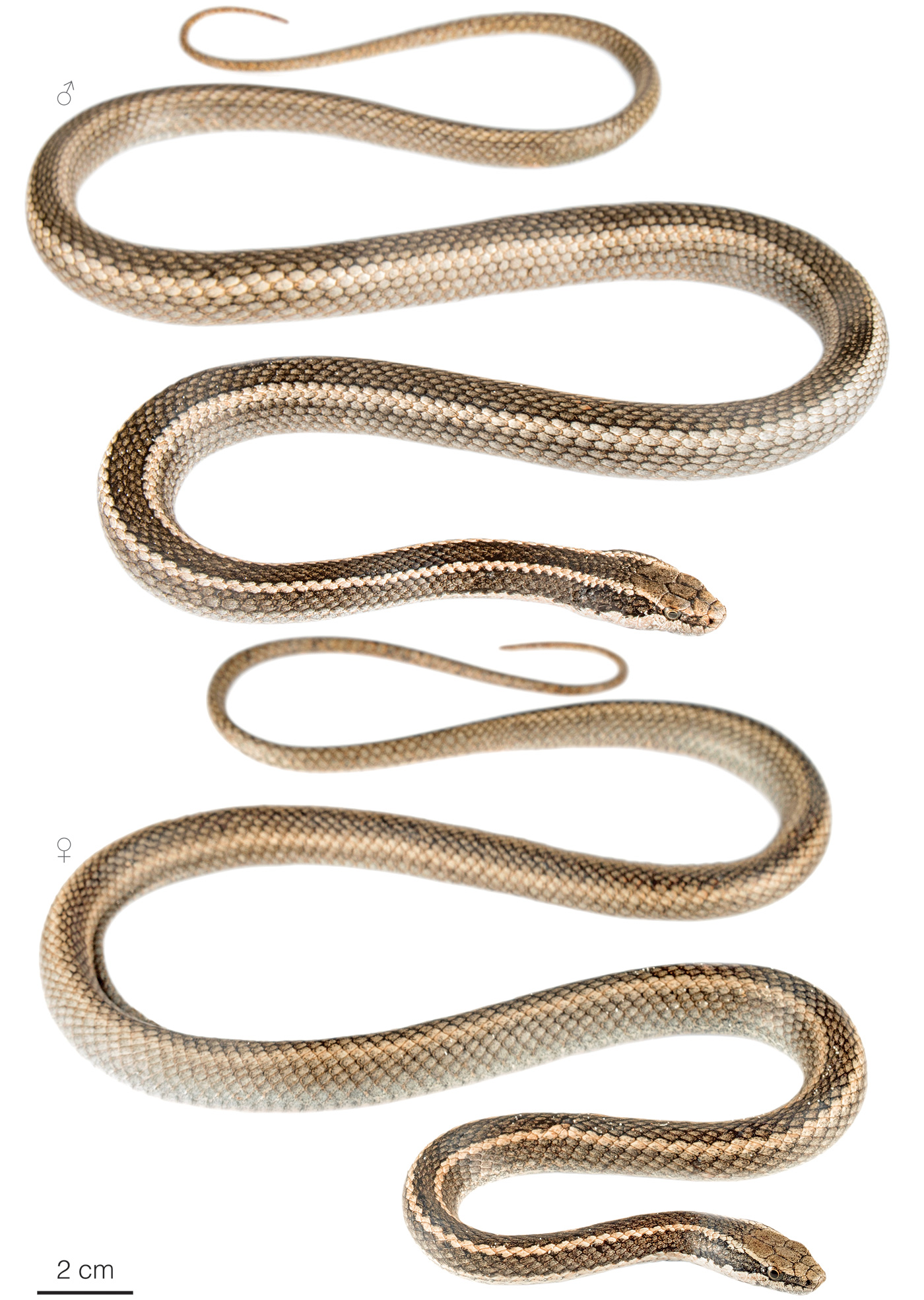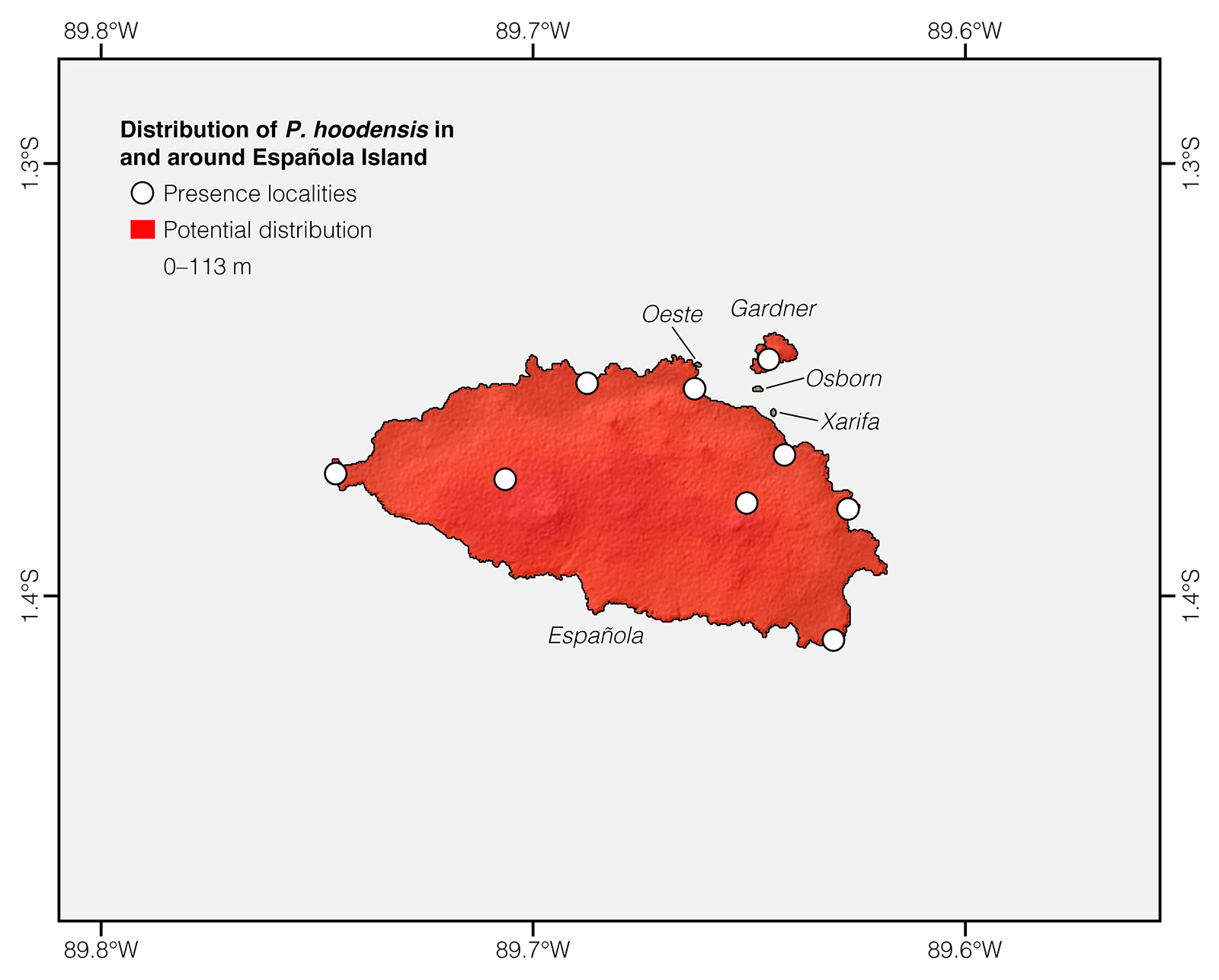Published October 10, 2019. Updated May 28, 2024. Open access. Peer-reviewed.
Española Island Racer (Pseudalsophis hoodensis)
Reptiles of Ecuador | Serpentes | Colubridae | Pseudalsophis hoodensis
English common names: Española Island Racer, Españolan Galápagos Racer.
Spanish common name: Culebra corredora de Española.
Recognition: ♂♂ 76.5 cmMaximum distance from the snout to the tip of the tail. Snout–vent length=54.8 cm. ♀♀ 113.8 cmMaximum distance from the snout to the tip of the tail. Snout–vent length=85.6 cm..1 Pseudalsophis hoodensis is the only snake known to occur on Española Island and the adjacent Gardner Islet. It is characterized by having a pale grayish-brown dorsum with a series of light and dark longitudinal stripes (Fig. 1).1,2 Males and females of this species are similar in size and coloration and, generally, they can not be distinguished from one another based on external appearance alone.

Figure 1: Individuals of Pseudalsophis hoodensis from Gardner Bay, Española Island, Galápagos, Ecuador.
Natural history: Pseudalsophis hoodensis is a common terrestrial snakes that inhabits dry grasslands, shrublands, and seasonally dry forests.1–5 During the daytime, especially between 8:00 am and 5:00 pm, these snakes are typically seen swiftly moving on bare soil or among shrubs and rocks.2,5 Galápagos racer snakes in general are mildly venomous, which means they are dangerous to small prey, but not to humans. The diet in P. hoodensis includes lizards (Microlophus delanonis and Phyllodactylus gorii), birds, and even conspecific snakes.3,4 There are recorded instances of predation on members of this species, including by hawks and herons.4
Conservation: Near Threatened Not currently at risk of extinction, but requires some level of management to maintain healthy populations..6 Pseudalsophis hoodensis is listed in this category because this species is presumably not undergoing population declines or facing major immediate threats of extinction. Española Island is not populated by humans nor by exotic predators and is protected within the Galápagos National Park.2 However, since P. hoodensis is restricted to a small island, it is prone to be affected by random unpredictable events (like droughts and introduced species) within a short time period.2 Fortunately, it would seem that populations of the Española Island Racer have increased following eradication of invasive species.5
Distribution: Pseudalsophis hoodensis is endemic to Española Island and the adjacent Gardner Islet in Galápagos (Figs 2, 3), spanning an area of approximately 61 km2.

Figure 2: Distribution of Pseudalsophis hoodensis in Galápagos. See Appendix 1 for a complete list of the presence localities included in the map.

Figure 3: Distribution of Pseudalsophis hoodensis in Española Island. The star corresponds to the type locality: Gardner Bay. See Appendix 1 for a complete list of the presence localities included in the map.
Etymology: The generic name Pseudalsophis comes from the Greek words pseudo (=false) and Alsophis (a genus of Caribbean snakes), referring to the similarity between snakes of the two genera.7 The specific epithet hoodensis refers to Española, previously known as Hood Island.2
See it in the wild: Like most snakes in Galápagos, Española Island Racers are secretive animals, but, with some luck, they can be seen during tourism day trips to Gardner Bay. The best time to look for snakes of this species is during the first hours after sunrise or right before sunset.
Special thanks to Eric Osterman for symbolically adopting the Española Island Racer and helping bring the Reptiles of Ecuador book project to life.
Click here to adopt a species.
Authors: Alejandro Arteaga,aAffiliation: Fundación Khamai, Reserva Arlequín, Ecoruta Paseo del Quinde km 56, Santa Rosa de Mindo, Pichincha 171202, Ecuador. Gabriela Aguiar,bIndependent researcher, Quito, Ecuador. and Juan M GuayasamincAffiliation: Universidad San Francisco de Quito, Quito, Ecuador.
Academic reviewers: Robert A ThomasdAffiliation: Loyola University, New Orleans, United States. and Luis Ortiz-CatedraleAffiliation: Massey University, Palmerston North, New Zealand.
Photographer: Jose VieirafAffiliation: Tropical Herping (TH), Quito, Ecuador.,gAffiliation: ExSitu, Quito, Ecuador.
How to cite? Arteaga A, Aguiar G, Guayasamin JM (2024) Española Island Racer (Pseudalsophis hoodensis). In: Arteaga A, Bustamante L, Vieira J (Eds) Reptiles of Ecuador: Life in the middle of the world. Available from: www.reptilesofecuador.com. DOI: 10.47051/RUON3914
Literature cited:
- Thomas RA (1997) Galápagos terrestrial snakes: biogeography and systematics. Herpetological Natural History 5: 19–40.
- Arteaga A, Bustamante L, Vieira J, Tapia W, Guayasamin JM (2019) Reptiles of the Galápagos: life on the Enchanted Islands. Tropical Herping, Quito, 208 pp. DOI: 10.47051/AQJU7348
- Van Denburgh J (1912) Expedition of the California Academy of Sciences to the Galápagos Islands, 1905-1906. IV. The snakes of the Galápagos Islands. Proceedings of the California Academy of Sciences 1: 323–374.
- Cisneros-Heredia DF, Reyes-Puig C (2023) Natural history and conservation of the Galápagos snake radiation. In: Lillywhite HB, Martins M (Eds) Islands and snakes. Oxford University Press, 158–182. DOI: 10.1093/oso/9780197641521.003.0009
- Altamirano MA (1991) Potential influences of biotic and abiotic factors on patterns of activity in Galápagos snakes. MSc thesis, University of New Mexico, 26 pp.
- Cisneros-Heredia DF, Márquez C (2017) Pseudalsophis hoodensis. The IUCN Red List of threatened species. Available from: www.iucnredlist.org. DOI: 10.2305/IUCN.UK.2017-2.RLTS.T190539A54447664.en
- Zaher H, Yánez-Muñoz MH, Rodrigues MT, Graboski R, Machado FA, Altamirano-Benavides M, Bonatto SL, Grazziotin FG (2018) Origin and hidden diversity within the poorly known Galápagos snake radiation (Serpentes: Dipsadidae). Systematics and Biodiversity 16: 614–642. DOI: 10.1080/14772000.2018.1478910
Appendix 1: Locality data used to create the distribution map of Pseudalsophis hoodensis in Ecuador (Fig. 2). Go to the section on symbols and abbreviations for a list of acronyms used. Asterisk (*) indicates type locality.
| Country | Province | Locality | Source |
| Ecuador | Galápagos | Bahía Gardner* | Van Denburgh 1912 |
| Ecuador | Galápagos | Española, centro | Cisneros-Heredia & Reyes-Puig 2023 |
| Ecuador | Galápagos | Gardner islet | Thomas 1997 |
| Ecuador | Galápagos | Hood, east coast | iNaturalist |
| Ecuador | Galápagos | Hood, north coast | Thomas 1997 |
| Ecuador | Galápagos | Hood, northeast coast | Thomas 1997 |
| Ecuador | Galápagos | Hood, southeast coast | Thomas 1997 |
| Ecuador | Galápagos | Meseta central de Española | Cisneros-Heredia & Reyes-Puig 2023 |
| Ecuador | Galápagos | Punta Cevallos, 4 km NW of | Thomas 1997 |
| Ecuador | Galápagos | Punta Suárez | Thomas 1997 |
| Ecuador | Galápagos | Punta Suárez, 3 km NE of | Cisneros-Heredia & Reyes-Puig 2023 |
| Ecuador | Galápagos | Punta Suárez, 4.8 km E of | Thomas 1997 |